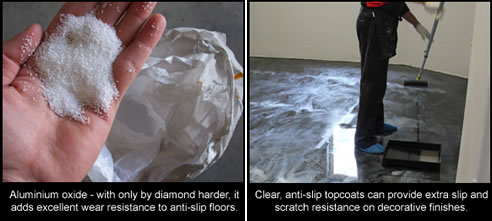NEWS ARTICLE ARCHIVESCleaning Decorative Anti-Slip Flooring from FLOORChef #Clean&Wear A one-minute article to stop slipping up on anti-slip floors #Clean&Wear In the last article (#Resin-basedOption) we covered the typical composition of a resin-based anti-slip floor. For our final article we want to hone in on particle selection for these floors and some other key considerations that come into play, i.e. cleaning and wear. A mop and bucket not always the answer We frequently get asked, "can you make it non-slip and easy to clean", but sometimes that combination just doesn't exist. The lighter end of the scale (R9-10) isn't the issue here because those floors typically have a light sprinkling of aggregate or a rounded particle that allows standard janitorial equipment such as mops to be used. (Tip - wet mopping can often push dirt around rather than pick it up. Using a wet vacuum to collect excess water, rather than letting it dry, works well) The challenge comes when more aggressive slip resistance (R12+) is required, e.g. in an abattoir. A mop will be torn to shreds very quickly here, so other options need to be explored. To clean these surfaces, you'll find the use of cleaning agents followed by a flush to drainage or a wet vacuum to be more successful. Be careful when picking the cleaning agent as not every resin can handle the harsh but popular caustic solutions, and, be wary of using hot water as it can damage your floor rapidly through thermal shock (as touched on in #Planning). Often those options are overkill, so using a pH neutral, surfactant-based product that works with cold water is a far better starting point. Go hard for less wear Keeping a floor clean via the methods above will help maintain slip resistance, however the hardness of the particle will have a big say as well. For anti-slip floors exposed to heavy machinery traffic and the brutal wear it can impart, particles at the high end of the Mohs hardness scale (i.e. aluminium oxide and carborundum at 9 rather than sand at 6-7) will deliver superior performance. Decorative AND anti-slip A final word on the wear of anti-slip floors relates to the "stir-in" options on the market. These finishes are very popular in the world of decorative floors because they add subtle anti-slip texture without hiding the design underneath, however they tend to wear more quickly than the specialist anti-slip systems. A couple of tips for improving performance in this area include selecting finishes that use glass beads rather than polymer particles and using two coats instead of one. If you have any questions about cleaning and wearing of resin-based anti-slip floors, please don't hesitate to contact me directly.
Keep Smiling, For more articles on anti-slip flooring, visit the YESChef! Blog |
 |
 |